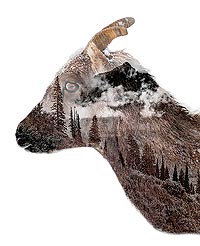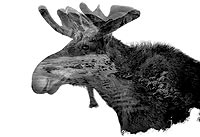 |
| Mark Brown has transformed his portrait of a mountain goat into a work of art by combining the image with a landscape scene of the place where goats live. |
Here’s a question that comes up from time to time: Can photography be considered an art form? There are some who say it is not, since all a photographer does is to press a button. This is an overly simplistic view and for a serious fine art photographer, is far from the truth. It makes no difference that others may use a camera merely to take snapshots. The tools may generally be the same, but the practices cannot be compared.
The same argument against photography as art can be applied to traditional forms. Should a fine art painter’s work be shown no respect because trained animals such as elephants and chimpanzees can hold a brush and put paint on paper? For that matter, is a painting of a can of tomato soup as created by Andy Warhol truly art or merely a visual joke?
Art has a long history that extends back into the mists of time. Humans have been making art for thousands of years, as seen in paintings on the walls of French and Spanish caves and even older petroglyphs in Africa. Here in the Moab area, we are constantly reminded of the past by the many petroglyphs and pictographs left behind by peoples who lived here long ago.
Most traditional art forms involve the representation of visual images, whether by incising into stone, painting on canvas, or cutting a linoleum block and using it to make prints. Photographers capture images, too, and even from the earliest days of photography there was more to it than merely pushing a button. Who can deny respect for someone like Ansel Adams, who would sometimes spend days in his darkroom learning to make the finest possible print from a negative?
Photography has evolved from tintypes to glass plates to film to sensors. With that last step from an analog to a digital form have come myriad ways to control and enhance images. Instead of stone, canvas or paper, today’s fine art photographer works on a computer monitor using software tools. These offer powerful opportunities for creativity, and for the development of distinctive styles.
 |
| In this example, a moose has been combined in a composite image that captures the sense of the animal in its environment. |
As an example of how photography can become art, witness the work of Moab resident Mark Brown, who is my partner at Moab Printworks and Gallery. Through his persistence in finding the right subjects and capturing them when the light is right, Mark’s creativity shows through in everything he does. It’s all about his connection with nature and love of the visual treat that is our Earth. Here are two examples of how he uses photography to express that love of the land, composite photographs that combine wild animals with their environment.
In each of these, two images have been combined to create pictures that tell stories. There is a mountain goat that has been digitally outlined to take away its surroundings. Then, Mark has used Photoshop to superimpose over the goat’s head a view of the mountain landscape where the goat lives.
In another example, he does something similar with his picture of a moose, again removing the animal from its setting and superimposing upon it a scene of natural beauty.
To see more of Mark’s work, stop by Moab Printworks & Gallery. We’re located in South Town Plaza near Rick’s Glass and are open 9-5 except on Sunday. We’re also a source of custom picture framing and photo tours and workshops.
_____________________________________________
David L. Brown is a landscape photographer who has led photo tours from his base in Moab since 2015, now as Printworks Photo Tours. His fine art prints can be seen at Printworks Gallery, 1105 S. Hwy. 191. He invites you to visit or call at 435-355-0121.
|